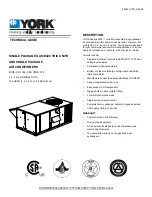
7
www.enviromaster.com/vpac
Enviromaster International, LLC
!
!
!
!
MAINTENANCE
WARNING
Before accessing the control compartment, discon-
nect power to the unit. Failure to do so could result
in serious injury or electrical shock.
The VPAC/VPHP 30-36 is designed and constructed
for reliability and long life minimal maintenance. Sched-
uled maintenance inspections should be performed 4
times a year. At the beginning of the cooling season,
a complete mechanical cooling check should be per-
formed and periodic minor inspections may be nec-
essary during the cooling season to adjust for varia-
tions in climate. At the beginning of the heating sea-
son, a complete mechanical heating check should be
performed and, again, periodic minor inspections may
be necessary to adjust for climatic changes.
WARNING
It is illegal to discharge refrigerant into the atmo-
sphere. Use proper reclaiming methods and equip-
ment when repairing this unit. Service should be
performed by a qualified service agency.
1. Disconnect power to the unit.
2. Remove the access panel and do a visual check
of the equipment. Look for obvious changes in the
unit such as damaged coils or evidence of extended
wear on any moving parts. Check for unusual odors
or leaks (ex: burnt motor windings, water, or refrig-
erant) and make sure the base pan is clean.
3. Regular cleaning of the filter is required. Allow-
ing dust to collect on the filter will cause the unit to
lose efficiency and eventually malfunction. Check
filter once a month.
4. Inspect all electrical connections for frayed wires
and poor connections. Terminal ends that are loose
will eventually fail, causing a loss of performance
or worse.
5. Check fan motors and blower assemblies. Some
units may require a drop of light oil to motors and/
or bearing assemblies. Check setscrews and mo-
tor mounting hardware, making sure these are tight.
6. Centrifugal fan blades and blower cage assem-
blies must be clean to operate efficiently. Brush and/
or vacuum as necessary.
7. Inspect both indoor and outdoor coils. Use a fin
comb to straighten out any damaged fins. These
coils must be clean for proper operation.
IMPORTANT:
Do not use a solvent-based cleaner
for this as some solvents produce a noxious odor
when you start the fan or electric heat.
8. Look for oil leaks or stains on or around the coil
and refrigerant lines. The presence of oil here indi-
cates a potentially serious problem (such as a re-
frigerant leak).
9. Inspect and clean the drain pan and drain line(s).
A good idea here is to use an anti-fungicide tablet
to keep the condensate system free from bacterial
contaminants.
10. Check seal around the unit.
IMPORTANT:
Air leaks may make the conditioned
area uncomfortably drafty or produce noises.
Visually inspect the foam gasket between the wall
and the unit, especially taking note of the separation
between the air inlet for the condenser and the
condenser coil discharge.
These two areas must
be sealed off from each other.
If you experience
poor cooling operation or erratic operation, check
for air recirculation at the condenser coil.
11. Replace panel and reconnect the electrical
power.
TROUBLESHOOTING
NO HEAT OR COOLING
Check to see if the unit has power and if the thermostat
is satisfied. If the thermostat is not satisfied, call your
installing contractor or service contractor.


























